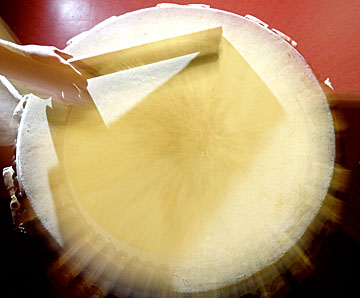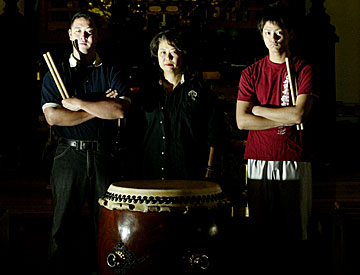
JAMM AQUINO / JAQUINO@STARBULLETIN.COM
Faye Komagata, founder and director of of Hawaii Matsuri Taiko, center, is flanked by her son Shuji, left, a taiko instructor, and nephew Keiji Ogikubo. The Komagatas and Ogikubo say taiko is much more than just drumming -- it is the continuation of a tradition.
|
|
The Beat goes On
The founder of an Oahu drum group has helped the ancient art flourish
FOR more than 20 years, Hawaii Matsuri Taiko founder Faye Komagata has watched youngsters get hooked on the Japanese art of drumming. Dozens, if not hundreds, of Oahu residents have grown up making the trek to the Wahiawa Soto Mission for classes. A handful of students, including Komagata's son Shuji and his wife, Jaymie, continue to participate.
"I want people to be aware of what taiko means as far as the culture," Komagata said. "It's something we're trying to perpetuate here in Hawaii."
The taiko group will be among the Japanese and Okinawan entertainers at next Sunday's New Year's Ohana Festival sponsored by the Japanese Cultural Center of Hawaii. The annual event will include traditional dance, swordplay, music and martial arts, as well as the beat of the drums.
WHEN KOMAGATA moved to Oahu from the Big Island in 1981, taiko had not yet undergone the renaissance that has led to more than 200 performing groups in North America, Europe and other parts of Asia.
Literally meaning "big drum" in Japanese, taiko has ties to religion and ancient warfare in addition to being used in traditional kabuki performances. In feudal times, drums were used to muster troops for attack. They have also long been used during the annual bon dance season.
According to Thomas Kelley's "The Taiko Journey," the progression of kumidaiko, or the ensemble performance of taiko drumming, began about 50 years ago and reached the United States in the early 1960s.
On Oahu, Komagata noticed an interest in taiko by some of her Japanese school students but a lack of any structured programs for them to participate in.
"I thought maybe we should try it year-round," she said. "In Kona, I used to just play at the bon dances. When we moved to Honolulu, I learned a little more taiko from a friend from Japan, and we kind of went from there."
Only a handful of students were enrolled at first, but word began to spread as different organizations asked the group to perform. Komagata's martial arts background and dedication to success motivated her to improve her students' quality of play.
"In those days, were kind of junk," she laughed, recalling the early days. "My goal was to make sure we were the best we could be, which meant that I would have to go out of town to practice and train, and also invite people to come in and conduct workshops.
"And because we did that, I think our group, especially those who remained for over five years, became very good in the art."
THERE WASN'T a choice for Shuji Komagata, who started taking classes before his family moved to Wahiawa. Just as some kids are forced to attend ballet class or piano lessons, he was thrust into the world of taiko.
And while he admittedly wasn't the best student back in the day, he now realizes that his life wouldn't be the same if it wasn't for those drums.
"In the beginning it really takes the dedication of the parents involved to keep the children motivated," he said, "but over time you kind of realize that this is the kind of stuff that's important."
Throughout his years at Leilehua High School and the University of Hawaii at Manoa, Shuji continued to practice and perform with HMT. Although he switched to the San Francisco Taiko Dojo while studying for his master's degree, Shuji returned to his roots and has since taken a bigger part in sharing the teaching role with his mother. His wife, Jaymie, has also been in the group since high school and is now teaching their youngest students.
"There are some other players who are still here, that kind of took the same route with church and Japanese school," Shuji explained. "It's just one of the things that's been with me as far back as I can remember. There isn't a time I can remember without taiko -- it's just part of my identity."

JAMM AQUINO / JAQUINO@STARBULLETIN.COM
Faye Komagata has passed on a passion for taiko to her son Shuji, left, a taiko instructor, and nephew Keiji Ogikubo.
|
|
TAIKO CONTINUES its hold on the Komagata clan, with yet another family member establishing himself with Hawaii Matsuri Taiko and the next generation of drummers already taking classes.
Shuji's daughter, Remi Komagata, is only 3 years old but is already pounding away alongside 5- and 6-year-olds during class in Wahiawa.
"She's a little preoccupied with other things during class," her father laughed, "but she's learning!"
For Komagata's nephew, Keiji Ogikubo, taiko had only been something he watched others doing while growing up in Japan. It wasn't until he arrived in Hawaii and moved in with his aunt five years ago that drumming became a bigger part of his life.
"I didn't really have a choice," he said. "It's because I live with her."
As he's progressed, however, Keiji has warmed up to the idea of taiko performance. HMT has a tradition of traveling to the mainland for conferences and to play in concerts. They also perform regularly on the neighbor islands.
And like the rest of his family, Keiji finds joy in teaching others what he's learned.
"I have a bigger part, so I have more responsibility," he said. "I've learned to really like (taiko)."
HAVING HER family remain involved is something Komagata takes pride in, said her son. While some students said she was strict as they were growing up, a number have since returned to tell her that the lessons they learned and people they met while traveling and performing with the group helped shape them into who they are today.
"I couldn't see myself living my life without (taiko)," Shuji said. "One thing my mother has tried to instill in other people, and that has carried on, is that these things are important to us. Not only the culture, but respect for the music and traditions.
"It's a tribute to (her), and I think (she's) happy about that."
NEW YEAR'S OHANA FESTIVAL
"Honoring our heritage. Embracing our diversity. Sharing our future."
» Featuring: Traditional food and entertainment, art displays and demonstrations, crafts, antiques, book sale, keiki kimono dressing, games and rides .
» When: 10 a.m. to 4 p.m. next Sunday
» Place: Japanese Cultural Center of Hawaii and Mo'ili'ili Field
» Parking: Free at University of Hawaii parking structure on Dole Street, with free shuttle
» Admission: Free
» Call: 945-7633 or visit www.jcch.com
|

